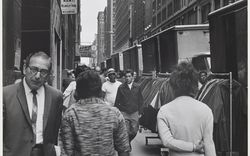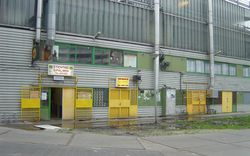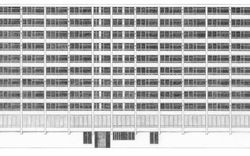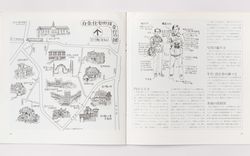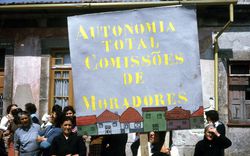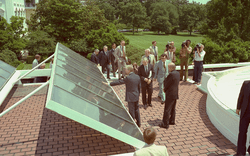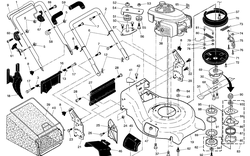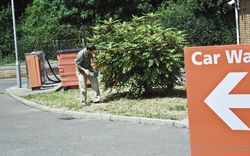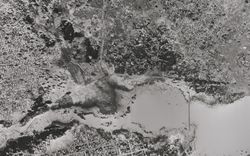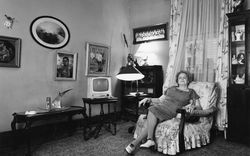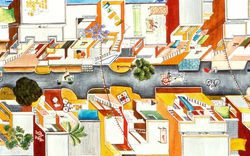Interpreting Modernism: How an Amsterdam housing development changes when Suriname gains independence
Text by Wouter Oostendorp and Jouke Sieswerda
This is the true story of a fictional flat. The events described in this story all happened in various places throughout the Bijlmermeer from 1968 to 1995. For the benefit of the narrative we have condensed these events and tell the story of one exemplary building.
Prologue
She was built at the end of the post-war reconstruction era in the capital of the Netherlands: Amsterdam. She was, however, not an ordinary building, nor located in an ordinary part of town, but part of the most beautiful and most modern town ever: the Bijlmermeer. The Bijlmer (as this part of Amsterdam is colloquially called) was the architectural embodiment of the Dutch welfare state and a shining example of Modern urban planning—better than the canals, better than Berlage, and better than the General Expansion Plan (Algemeen Uitbreidingsplan or AUP).
She was raised to be the ultimate solution for the polluted, dilapidated, and crowded cities. A modern city expansion in its purest form: large dwellings arranged in high-rise flats, placed in a lush and green environment. A strict segregation of program would guarantee a quiet and clean neighbourhood with an abundance of leisure possibilities. It would be the safest living environment in the country, as the motorized traffic—lifted high above the ground—was completely isolated from pedestrians and cyclists. She was taught the principles of light, air, and space; an emancipatory machine that would allow (middle class) people and communities to flourish, she was, in short, the “city of the future.”
It is apparent that her parents had, as parents do, great expectations. And, as often is the case, her life story is much less straightforward. It was more like a winding road with a lot of unexpected turns. It is not a happy story, but it is not a tragedy either: between the lines interesting things can be found and important things can be learned.
Read more
Youth
Although she was built in the late 1960s, she had existed in the minds of her designers much longer than that. As it became clear that the Western Garden Cities, built under the AUP, would not be sufficient to deal with the increase in population (the post-war baby boom) and the higher living standards (fewer people in bigger dwellings) a new solution had to be found; a quick, cheap and, at the same time, prestigious solution.
The name of her father was Siegfried Nassuth; he led the design team of Amsterdam’s Department of City Development. He was a man with a strict egalitarian vision of society who drew inspiration from the socialist housing schemes designed and built in the Soviet Union. These housing projects were designed with collective facilities, which were meant to relieve the worker’s load, stimulate communal life, and emancipate the masses. For the Bijlmer, Nassuth envisioned equal opportunities for everyone and ample possibilities for the personal development of its inhabitants; the urban fabric would express and facilitate these values.
If Nassuth was her father then Cornelis van Eesteren was her grandfather. The ideas of the Department of City Development in Nassuth’s time stemmed directly from principles formulated by CIAM (1928–1959) and Functional Modernism. These were introduced to the Netherlands by Van Eesteren, who had been chairman of CIAM and the head of the Department of City Development before Nassuth. He also had been one of the designers of the AUP, which formed the basis of the new radial structure of Amsterdam; satellite cities fanned out from the city core, separated from each other by vast green spaces. To the southeast lay the Bijlmermeerpolder, the last remaining possibility for expansion. Here the next step in the renowned urban planning tradition of Amsterdam would be made. The Bijlmer had to be an even more thorough and consequent execution of the Modernist planning principles than the Western Garden Cities built under the AUP.
She was built with the latest industrial techniques. These were times of serious housing shortages and the challenge was to build fast and in great numbers. She was therefore cast in concrete, with a façade of concrete bricks and long concrete galleries. She rose ten storeys high and bent twice at a 120-degree angle. When she was ready they named her Bloemenoord.
Because of the pressing demand for middle class (single family) housing she was the first of a big family. Her siblings, born soon after her, were given illustrious names like Frissenstein, Grubbehoeven, and Kruitberg. The whole family together formed hexagonal patterns that from above vaguely looked like a honeycomb. All the flats were connected by an indoor pedestrian street on the first floor, but more importantly these corridors connected the whole family with the parking garages and through this with the highways and rest of the city. The inhabitants would reach the garage by car and walk to their homes without getting wet and without touching the ground. Traditional (crowded and dangerous) streets were made obsolete. It was a kind of Jetson-like fantasy, with fly-overs, sky bridges, ultra modern docking stations, and a baggage service that would reach from your car to your apartment.
Inhabitants would enter the Bijlmer via one of the elevated roads looking down on the green fields and parks. Due to industrialization and mechanization people would have much more free time; the green courtyards would be ideal for all kinds of leisure activities. Driving on the high roads one could watch the spectacle below. But the monumental apartment buildings would tower above everything else. Coming closer to Bloemenoord the exit-ramp would lead directly to the parking garage. From here the indoor street would provide access to the elevators. The street would be sunny and lined with collective facilities like bars, daycares, play areas, and hobby rooms; it would generate liveliness and form the heart of social life in the building. These collective spaces were essential to the Bijlmer plan as they would compensate for the drawbacks of living in a high-rise and would be the ultimate expression of collective living. The elevators rose up to the galleries, leaving behind the bustling activity. The galleries offered spectacular views and gave access to the private domains.
The apartments, with an average size of 100 square metres, were quite big, certainly compared with those in the Western Garden Cities, which measured 70 square metres on average. They would be equipped with the most modern kitchens, bathrooms and fixtures; ideal for modern living.
In line with Nassuth’s egalitarian and industrial principles, he raised all his kids the same. Ninety percent of all dwellings in the Bijlmermeer were located in high-rises like Bloemenoord. And of those apartments the biggest part were intended for typical Dutch families and had five rooms. The layout of the plans was sober but well designed. There was a kitchen near the entrance, a living room down the hall, and three bedrooms and a bathroom to the right. The hallway between the bedrooms could function as a play area for the kids. The whole building was designed as a machine for living, and a very specific way of living at that.
Bloemenoord’s youth was relatively carefree and her first steps were promising. The plans were met with great enthusiasm by architects and politicians. The scarce notes of criticism were drowned by the high praise of the press. Most people seemed to agree that this was indeed the future of the city. The first people to take up residence in Bloemenoord in 1968 were pioneers who believed a new way of living was possible here. These people, however, were not all large families with three or four children and a dog. They were intellectuals, artists, gays, and socialists. A different crowd than foreseen, but a crowd determined to make the most of their new home. They all came to the Bijlmer with a shared belief in a new society; a society where people lived together and had the opportunity to fully develop themselves.
The planners, however, had not really thought about the management of the collective facilities. Bloemenoord was furnished with a couple of undetermined spaces, but who was to pay for their use? When the housing corporation figured that the inhabitants had to rent these collective spaces if they wanted to use them, they remained empty… but only for a while. These pioneers had come to live here for a reason, after all. After a lot of meetings and much protesting to no avail, they simply broke open the door and squatted a couple of the spaces in the belly of Bloemenoord. They christened the space “Binnenpret” (inside joke) and started a bar, a cafeteria, and… a TV station. This was quite easy: all the TV cables were already built in; it was just a matter of tapping into the system. At first the transmissions were of a practical nature (cooking, do-it-yourself tips, etc.) but later on politicians also came over for an interview.
Soon all kinds of informal activity sprung up. Since a lot of journalists happened to live in the Bijlmer, a newspaper was easily started and would stay around for quite some time. Other establishments emerged, like the Café de Nachtegaal and the Bonte Kraai bar. After a few years, the corporations and the municipality finally caught up with the inhabitants and subsidized the building of a pavilion right between Bloemenoord and one of her brothers (of course connected with the corridors on the first floor). The TV station moved there, and the bar as well. There were places for meetings, tables for card games, and a snooker table. The famous musician/doctor Boy Edgar gave performances there and started something of a jazz tradition that carried on long after his death.
There was no lack of drive and initiative. The new inhabitants stuck together, especially when there were issues with the housing corporation or the municipality. When the architect of Bloemenoord decided it was time to install the plating on the (up till now) semi-transparent fence, the residents picked up their wrenches and screwdrivers and removed the plating in one evening. They were reattached more firmly the next time, but with crowbars they were just as easily taken down again. In the end the housing corporation let the people decide for themselves. The people from the Bijlmer knew very well what they wanted, and what they did not want.
The people in the Bijlmer were resourceful, but it is clear that the situation was far from ideal and more issues kept requiring their attention. Bloemenoord and her family found herself quite isolated from the rest of the city. The planned (and promised) subway connection to the centre had still not been built, neither had the big shopping centre (with all the facilities that a city needs). The few collective spaces that were actually built proved to be bare and expensive, and nobody had really thought about who was to maintain them and pay for them. It all came down to the enthusiasm and professionalism of the inhabitants.
Meanwhile, the rents kept going up. The ambitious plan had turned out to be much more expensive than expected: overall building costs had increased drastically and labour wages had exploded before construction began. Moreover, the contractors drove a hard bargain and the subsidies from the national government were cut. The apartments became so expensive to build that they could not be rented out as social housing any more and they were placed in the “free sector.” Social housing was subsidized and regulated by the government while the free sector was open to anyone who could afford it. This shift was meant to keep the plan affordable, but more drastic actions were necessary. Under the influence of the contractors and the government the plan was stripped to its core. More and more siblings were born, but with fewer and fewer facilities: distant cousins without collective spaces, with smaller apartments, with longer galleries and fewer elevators. And, as there was no money left for the proper maintenance of gardens and parks, more and more of these identical apartments stood alone in an empty, windy expanse.
People started to protest against the high prices and the promises that were not kept. Where was the bustling liveliness? Where was the Garden of Eden? Where was the city of the future?
After numerous strenuous (but ultimately useless) protests, people started to abandon Bloemenoord. There were other places they could go, after all. Just as construction of the Bijlmer started, the national government enacted a new memorandum on spatial planning. Instead of dealing with the housing shortage within the city limits, the new strategy was to build on the outskirts of smallish towns and villages. Suburbia, the government had decided, was the new city of the future.
All of this led to an increasing vacancy rate and apartments were left empty. But when our heroine looked around her she could still see new nephews and nieces arriving. The municipality—in their haste to build as fast as possible—had already given out the contracts to the builders. Flats were still being built at a fast and steady pace, even though there was no one to live in them.
Adolescence
At this point another story becomes important. Forty-seven hundred miles southwest of the Netherlands lay one of the last remnants of the Dutch colonial empire: Suriname. It had been part of the kingdom since 1667, and since the 1950s Surinamese had been coming to the Netherlands in search of better prospects. The early 1970s saw increasing unrest in the colony as it was working towards independence. A lot of Surinamese were already living in the Netherlands by then, but a great deal more moved here while they were still sure they had Dutch passports. When Suriname gained its independence in 1975 the Dutch government offered the Surinamese people the choice over their nationality, which caused a drastic increase in Amsterdam-bound emigrants on the flights toward Europe. In the end there were almost as many Surinamese living in the Netherlands as in Suriname.
The government had to deal with this increased influx of newcomers. Their initial strategy was one of dispersal. Spreading out these “new” Dutch citizens in small groups across the country was believed to stimulate the integration process. As the Surinamese arrived at Schiphol airport, their first stop was Amsterdam. Here they were temporarily housed, in decrepit but expensive pensions, awaiting their relocation to smaller towns all over the country. For a lot of them, however, Amsterdam was the final stop. No one really wanted to take care of these newcomers and the smaller municipalities simply did not have the means. The pensions proved to be very expensive for the city and, like a good deal of the housing stock, in very bad shape. Quickly, an alternative had to be found.
These newcomers, though, presented Dutch legislation with a problem. The strict rules and guidelines regarding the social housing sector were not designed for this situation. It was impossible for immigrants to apply for social housing. The only option that remained was the free sector.
This is where Bloemenoord re-enters the story. The complaints of the inhabitants had not gone unnoticed and the now overwhelmingly negative publicity in the press had caused her image to come to an all-time low, and as a result the vacancy rate was going up. At the same time, there were some 3,500 Surinamese stuck in pensions in Amsterdam urgently looking for a place to live. It did not take long before the municipality started to direct them to the Bijlmer, where there were enough empty apartments. The high prices, though, led to overcrowding as numerous families had to share an apartment in order to pay the rent. In one known case there were twenty-four people living in one apartment: twelve adults and twelve children.
For a large part this migration also happened in a more natural manner. The Bijlmer was close to the airport and a lot of Surinamese already had (distant) relatives living there. Moving to the Bijlmer was a logical step. Together they created a little piece of Suriname in the Netherlands. By now the airline from Paramaribo to Amsterdam had been nicknamed “the Bijlmer Express”.
What these new Dutch citizens found there was not something they were used to. The newcomers imported a totally different living culture and they had a certain carefree way of adapting to their new surroundings. The tight modern machines, so specifically designed for the modern Dutch family, were reinvented in ways nobody had foreseen.
The generous apartments (by Dutch standards) in Bloemenoord were not big enough to accommodate the extended Surinamese families. As a result, some people simply connected multiple apartments themselves by breaking away either walls or floors. A bedroom turned out to be just as well suited for use as a dog kennel. Chickens could be kept in the kitchen sink. And why could a campfire not be lit in the living room?
Walking along the galleries you could now smell exotic food coming from the kitchens. Some of the apartments were even turned into makeshift restaurants. The smells and tastes from Suriname were never far away. A couple of floors down, the indoor street could be mistaken for a market. All kinds of exotic fruits and vegetables could be found here.
Bloemenoord was not designed for the specific needs of this totally different group of people. The Surinamese were used to spending a good part of their day outdoors. The Dutch climate made this impossible most of the year. Transferring all their activities inside caused some nuisance, to say the least. The poorly insulated apartments were not designed for extensive cooking, music making, animated conversation or parties.
They also imported their religious beliefs. Although for a good part Catholic, a lot of Surinamese also still adhered to traditional ideas about their ancestors’ spirits: the winds or Winti. Some apartments doubled as informal Winti temples. People could come here to get medical or spiritual assistance from a Winti priest. Public life was not attuned to these newcomers. Where could they house their churches? Where could they celebrate weddings? Space was soon found in the disused parking garages. All over the Bijlmer churches nestled in the most tucked away places. Only the gospel music gave outsiders any clue as to what went on there.
What did catch the eye were the brightly coloured birds that would be brought out on warm summer days. In the parks of the Bijlmer the Surinamese continued their tradition of bird-singing contests. Two caged male birds would be placed next to each other and the one that sang most frequently within a five-minute time frame was the winner. Especially popular was the betting that took place during the contests. Illegal bird importation flourished: they were transported rolled up in a newspaper or strapped to a leg. The pet stores offered an enormous variety of tropical birds and other animals.
The way the Surinamese settled in the Bijlmermeer illustrates the selforganizing capacity of the neighbourhood and its inhabitants. This slightly anarchistic tradition was started by the idealistic pioneers and was carried on by the newcomers in the 1970s and 1980s. Whatever lacked in their neighbourhood, whether it was a bar, a daycare or a church, the people from the Bijlmer just started themselves, informally.
Another great example is the petting zoo that sprang up at the feet of Bloemenoord; it is still there today. It started with two chickens and a couple of rabbits that needed to be looked after. They found a home in the storage facilities on the ground floor. Soon a rooster followed, and a couple of sheep. The farm had to move outdoors where, without any permits, a pigsty, a hay barn, a pony shed, and an information centre for school children were built. Everything was constructed by locals with materials that were lying around or could be obtained cheaply. The petting zoo was a big success. For a while the people from the Bijlmer even produced their own cheese.
Adulthood/Midlife Crisis
As said, all this curious and foreign behaviour caused quite some nuisance for the average Dutch population. It was not, however, just a cultural issue. Socioeconomics were also a factor, as a large part the Surinamese came from small villages; they were poor and still struggling to find their place in Dutch society. They were busy adapting, and not too fussed about throwing the garbage in the garbage chute. It could just as easily be thrown over the balcony.
The green spaces around Bloemenoord were now filled with litter and the strangest things were hanging from the trees. The staircases were used as a public toilet. The collective spaces were closed due to bad management. Instead of a lively and social meeting point, the corridors were now generally a place best avoided.
Meanwhile, reports were published on the “criminal behaviour of the coloured people.” Though it was true that the crime rate in the Bijlmer was relatively high, the population was also relatively young. Compared with native Dutch youths of the same age group the difference was actually not that big. But the problems were directly being associated with the high ratio of immigrants. This led in a lot of cases to a political and media focus on the ethnic factor, rather than a healthy debate about the social and economic issues that needed to be addressed. There was no doubt though that crime was an issue, and people did feel unsafe.
The housing corporation was very much aware of these problems and was afraid that they would accumulate in Bloemenoord. It enacted a dispersal policy: no more than 30% of the flats could be occupied by immigrants. This was, of course, racial discrimination but the alternative, they said, was the first ghetto known to the Netherlands.
The corporation, however, was not able to cope with the high vacancy rate indefinitely and with the statement, “We do not discriminate,” it abandoned the dispersal policy. This resulted in a further concentration of people who, because of their socioeconomic position, where not able to maintain their living environment. At the time, intensive socioeconomic assistance from the government did not yet exist so these people were left to their own devices. The disinterest in the living environment and its collective spaces was caused by the pure focus on survival, which was more important to its inhabitants than the maintenance of their neighbourhood.
The people that were already settled started complaining about the situation in Bloemenoord, first about the physical condition of the flats, but after a while more and more about the social problems. The municipality was not really interested in the socioeconomic situation of the people in Bloemenoord and the Bijlmer in general; the flats were, after all, free sector and therefore not their problem. The housing corporation, however, reacted to the situation by once again putting a stop to the Surinamese influx into Bloemenoord.
In the media and on the street nasty words like “Negro-ghetto” and “monkey-mountain” were heard with increasing frequency. Finally the Surinamese population had enough of the one-sided negative publicity. They broke into an empty school building and started a Caribbean Centre. They wanted to show the rest of the country what their culture had to offer. What is more, they finally wanted a decent place for their music, festivities, and social activities. They were not alone and got help from Antilleans, Hindus, and native Dutchmen. Future mayor of Amsterdam Ed van Thijn was one of the people supporting them; he called it a just cause, important for the whole country.
In the coming years, however, nothing really changed and the situation became untenable. As more people left the Bijlmer, more apartments remained vacant. As for Bloemenoord, more than 100 of her 800 apartments were vacant; apartments which were not appointed to the large number of Surinamese looking for a roof over their heads.
At this point, Surinamese people started to organize themselves into an action group called “the Beheersraad.” They did not accept that Surinamese were kept out of the Bijlmer while the municipality spent lots of money on pensions in other parts of the city. Complaints about this situation led to the development of a subdivision called Housing for Surinamese and Antilleans in the Bijlmermeer. They planned protest actions to gain publicity in the media about the discriminating policies and the huge need for proper housing for this group of people. They warned the corporations and municipality of action if they did not improve the situation. It led to nothing so they took matters into their own hands and started squatting eighty apartments for eighty families.
Now that the newcomers had organized themselves they were able to communicate directly with governmental organizations and discuss matters on a political level. They formed Committee 80, an umbrella group of municipal institutes, corporations, and the squatters. Its purpose was to find solutions for the situation in Bloemenoord. After a lot of meetings, discussions, and failed alternatives, the municipality finally gave the Surinamese access to the social housing program. The squatters were in large part tolerated and the families could stay.
With their actions and negotiations the Surinamese managed to free themselves from the “social lock down”—being stuck between social housing and the free sector—and finally found solidarity in Dutch society. The squatting arose from both a political motivation and a spatial need; it was an expression of a socio-economic tragedy. The Surinamese took Bloemenoord and used her notoriety to get publicity for their dreadful situation vis-à-vis the Dutch housing authorities.
Numerous other problems still lingered. Overcrowding, the poor condition of the flats, the filthiness, the bad transit connections with the city, the area’s bad image, and a severe lack of facilities and urban planning were issues that remained unresolved. As a result stable households left and people with a poor socioeconomic position took their place. During the 1980s and 1990s the problems kept piling up in the Bijlmer without any adequate response from the housing corporations, the municipality, or the government. Drug addicts and dealers started to find their way to Bloemenoord and the crime rates went up.
A lot of these shady activities were concentrated in the darker recesses of the Bijlmer: under the elevated roads, in abandoned parking garages, on the ground floor of the apartment buildings, that had been reserved for storage spaces. These storage rooms would become infamous throughout the country. Since the primary means of access to the flats were the corridors, people in their daily comings and goings had no reason to go to the ground floor. The plinths consisted of mostly blind facades hiding the storage units. There was no social control of the public space. The so-called “eyes on the street” were absent.
Bloemenoord’s ground floor became the ideal place for shady activities. Her storage rooms were converted into makeshift apartments, semi-professional brothels or hideouts for junkies. It became a place where you would not want to linger at night.
The Bijlmer had gotten stuck in a downward spiral. The original inhabitants’ criticism of the execution of the plan led to bad publicity early on, which made people stay away from the Bijlmer, resulting in vacancy. The vacancy attracted more problems and started a process of gradual slumming, which produced more negative attention.
Responsibility for the management of the flats lay with the housing corporations. Almost all of the corporations, however, were nearly bankrupt, and they were incapable of doing anything about the terrible conditions in the Bijlmer. Over the years there were numerous rescue plans for the Bijlmer, but they proved too little, too late. There was not the political will to save the Bijlmermeer. Not even a visionary plan from Rem Koolhaas in 1986 could change that. More and more people started considering demolition. In the mid-1990s the decision was finally made and a radical redevelopment plan for the Bijlmermeer was accepted. The renewal plan consisted of the demolition of about 50% of the high-rises, which were replaced by standard terraced housing units of two or three storeys: the same houses as everywhere else in the Netherlands. The future had finally caught up with the Bijlmer.
Old Age
Despite the numerous problems that arose, it is notable that serious racial tensions never occurred. The local soccer club was mixed from the beginning, there were bars where everybody walked in and out, and the youth also stuck together. And, where the people could not live with each other, they learned to live alongside each other. The Bijlmermeer functioned as the multicultural blueprint for the Netherlands. It was (and maybe still is) in many ways twenty years ahead of the rest of the country.
It has become the cultural epicentre of many nationalities. Besides Surinamese, over the years a lot of Ghanaians, Hindus, and many other ethnic groups also came to live in the Bijlmermeer. The Bijlmer is now known as the home of over a hundred nationalities. And even people who eventually move out of the area come back every Saturday for the lively and exotic market, which cannot be found anywhere else in the Netherlands.
People from the Bijlmer have always tried to show this more positive side of the Bijlmer. Numerous events were organized that—besides being fun for the inhabitants—had the clear aim of breaking the stigma of the neighbourhood. Blij-met-de-Bijlmer (Happy-with-the-Bijlmer), for instance, was organized right outside Bloemenoord in the large park between her and one of the sisters. It was a festival with music, theatre, film, and activities for children. It was organized solely by volunteers and was a modest success every year it was organized (it lasted for more than sixteen years).
But one of the things that people associate most with the Bijlmer nowadays is Kwakoe: a festival that started as a series of informal, self-organized soccer matches. Like so many things in the Bijlmer, it just started. But, as people began to bring in food and music, this makeshift football tournament gradually evolved into a yearly festival in the Bijlmer park. The Kwakoe festival is still one of the multicultural highlights in the Netherlands. It is visited by people from every ethnicity imaginable. They play sports, listen to music, dance, stroll around the market stalls, and eat exotic food. Almost 400,000 people, spread out over several weekends, visit the festival.
Though the Bijlmer has unrecognizably changed over the years, the spirit it has generated is still there. The Bijlmer is still the Bijlmer, it is (re)created every day by its inhabitants. And Kwakoe might just be its new icon.
Epilogue
In 1995 Bloemenoord was demolished. The housing corporation and the municipality decided it was time for drastic action; a clear signal to all that things were finally going to change. Interestingly enough, she was in nowhere near the terrible shape that some of her siblings were in. She was, however, quite conveniently situated: next to the Bijlmerdreef and very close to the new shopping centre.
She was the first to go, torn down piece by piece. Gradually revealing the lives that had been lived within. As a half demolished skeleton she regained some of her former grandeur. For a short time it felt like she was under construction again. And all dreams and expectations could still be projected on the concrete structure. She revealed her potential for all to see.
In her life Bloemenoord played different roles for different groups of people. For some people she was a refuge; a place where you could live in perfect anonymity. The towering apartments offered seclusion and a magnificent view. The first pioneers used her as a way of creating a new social structure. For them she was a utopian machine, a way of changing society. For the newcomers she played an important role in an emancipatory process. She functioned as a tool for a minority that was fighting for a position, recognition, and solidarity in Dutch society.
For most people, though, she formed the backdrop for daily life. A place where, despite all the problems, a lot of people felt at home.
Wouter Oostendorp is an architect based in Rotterdam, and co-founder of studio OxL. Jouke Sieswerda is an architect with ZUS (Zones Urbaines Sensibles), an Amsterdam-based practice. This text was first published in Journeys: How travelling fruit, ideas and buildings rearrange our environment, a book we produced in 2010.

